Abstract
1. Amiodarone is an effective antiarrhythmic drug whose therapeutic usefulness is limited by variable pharmacokinetics and considerable toxicity. Total plasma concentrations are not reliably related to therapeutic effect, but if plasma protein binding varies between patients, then free drug concentrations may provide a better measure of drug effectiveness. 2. The plasma protein binding of amiodarone was measured by erythrocyte partitioning, and found to be the same in six healthy subjects and eight patients being treated for cardiac arrhythmias (mean = 99.98%; range 99.97-99.99%). The free fraction of amiodarone was independent of the total drug concentration (r = -0.41, P greater than 0.50) and albumin level (r = -0.31, P greater than 0.50). 3. These data show no advantage in monitoring free concentrations of amiodarone. On the other hand, the patients in this study did not receive very high doses of amiodarone, and were free from drug side effects and biochemical abnormalities. Possibly a more heterogeneous group of patients would show variability in amiodarone binding. This should be examined, especially for patients with variations in alpha 1-acid glycoprotein, a major ligand for basic drugs and a likely major binding protein for amiodarone.
Full text
PDF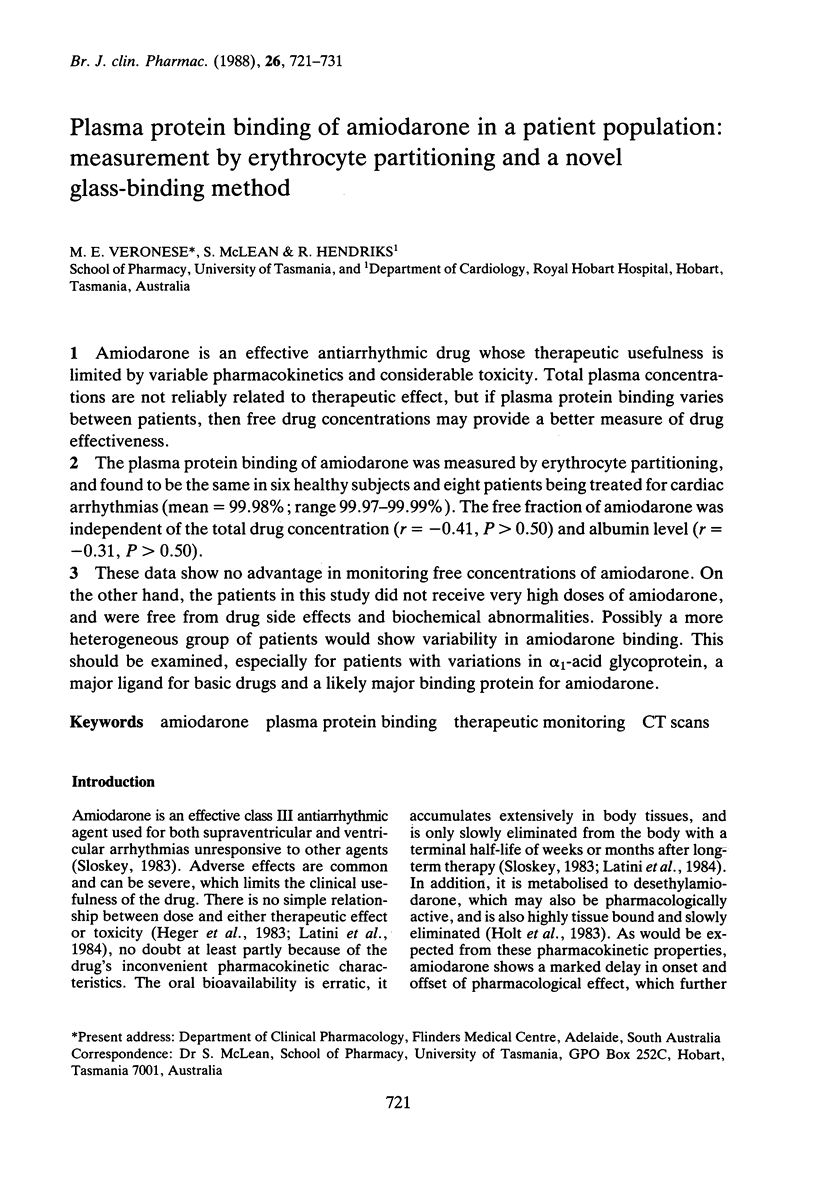
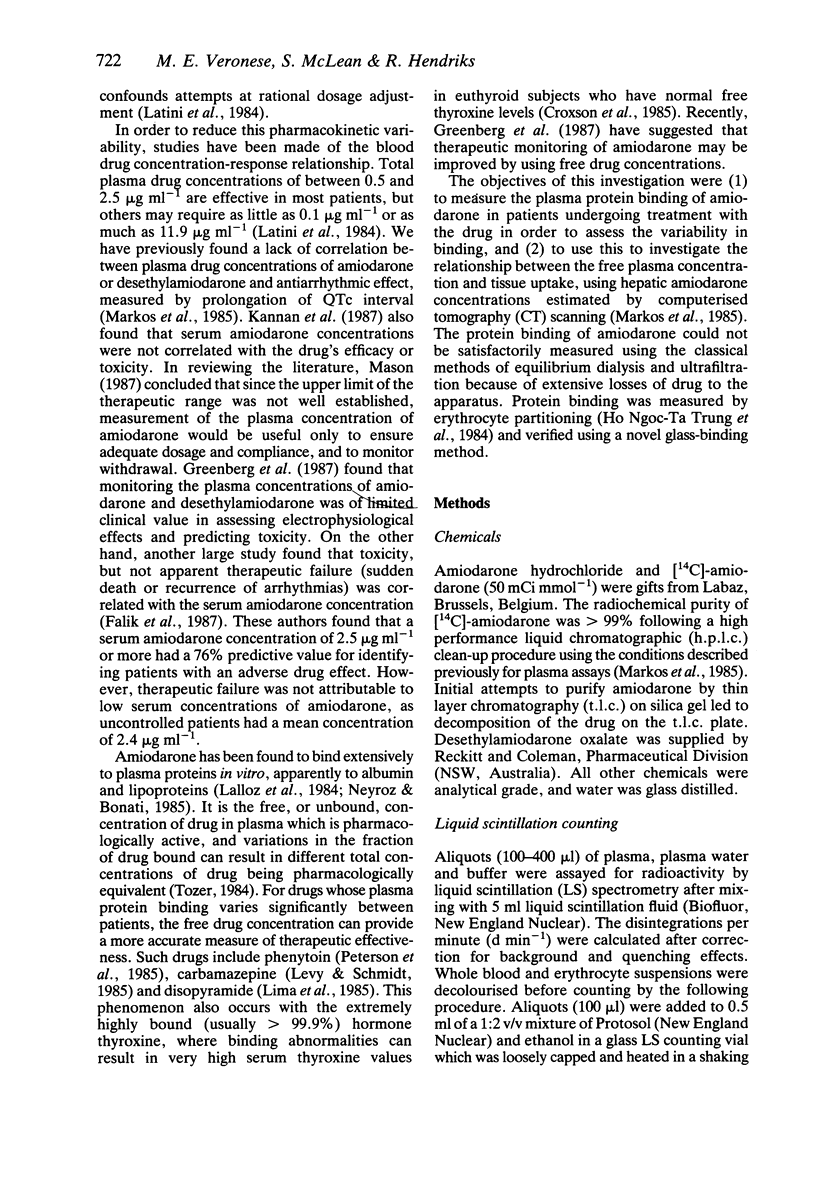
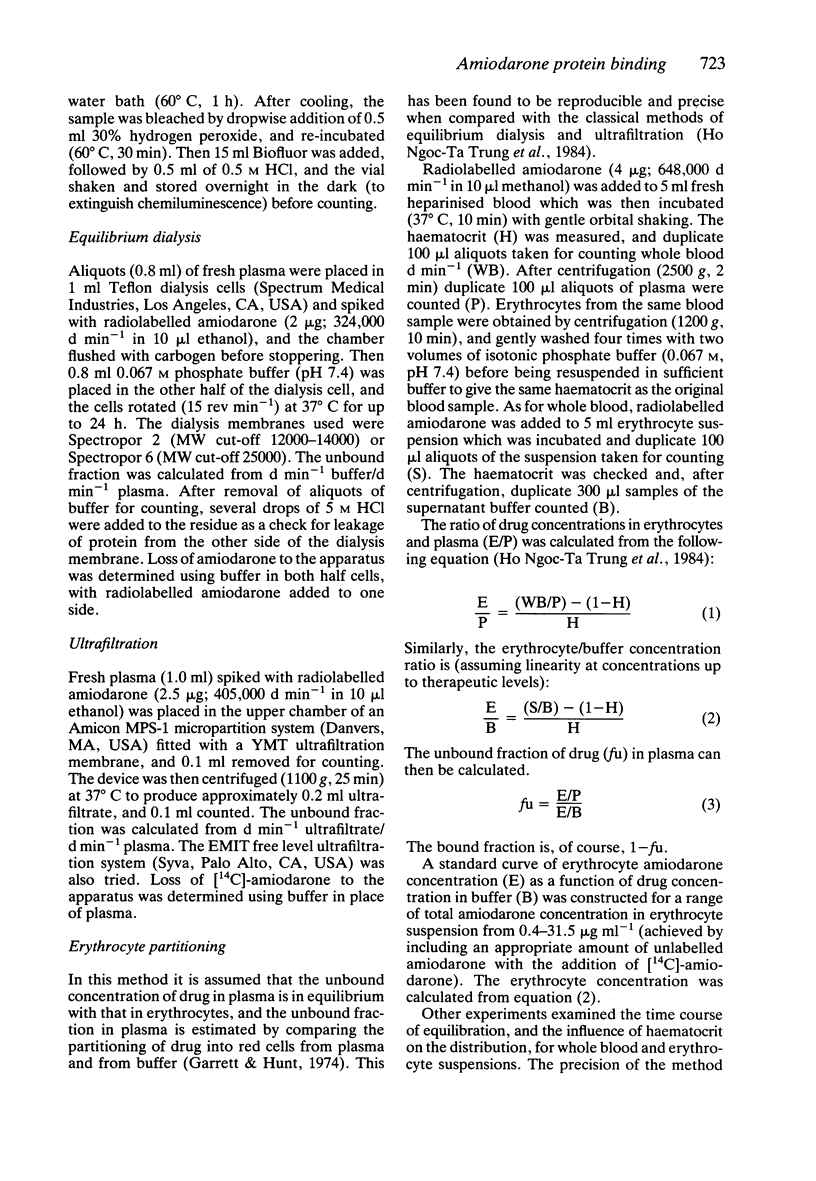
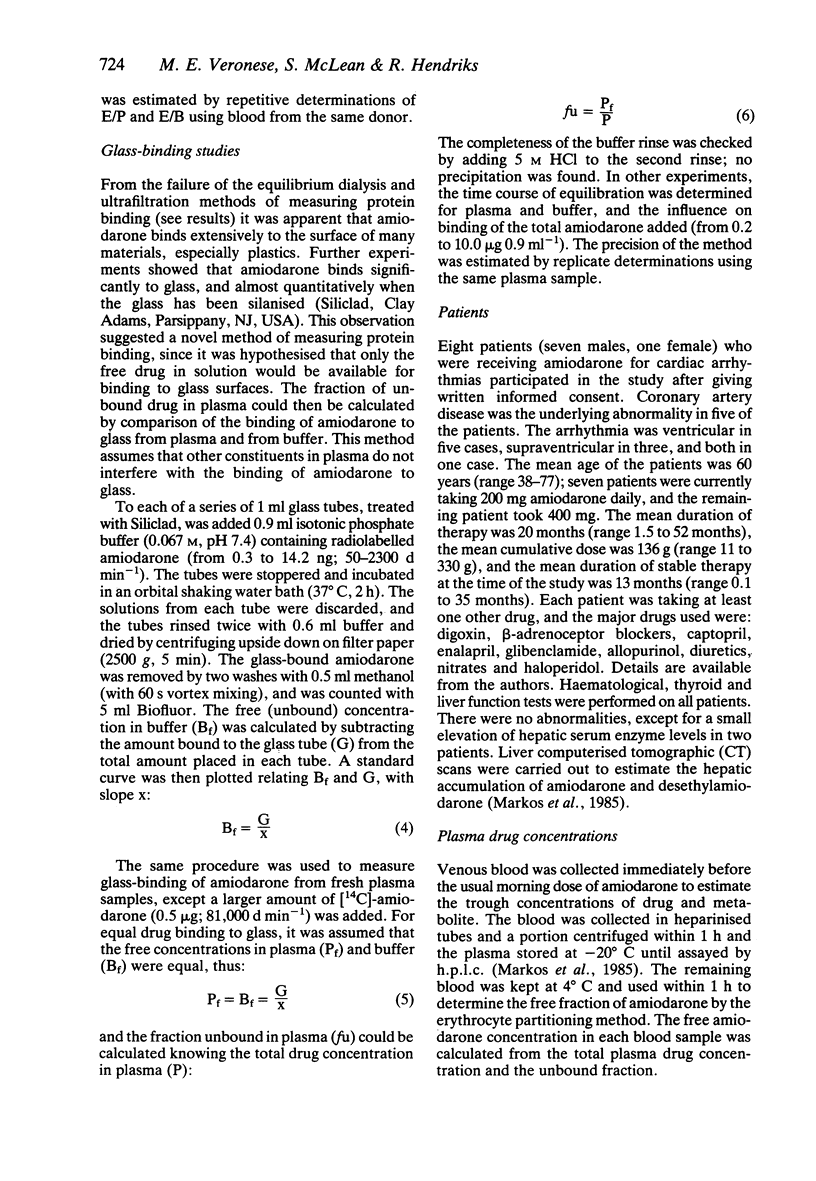
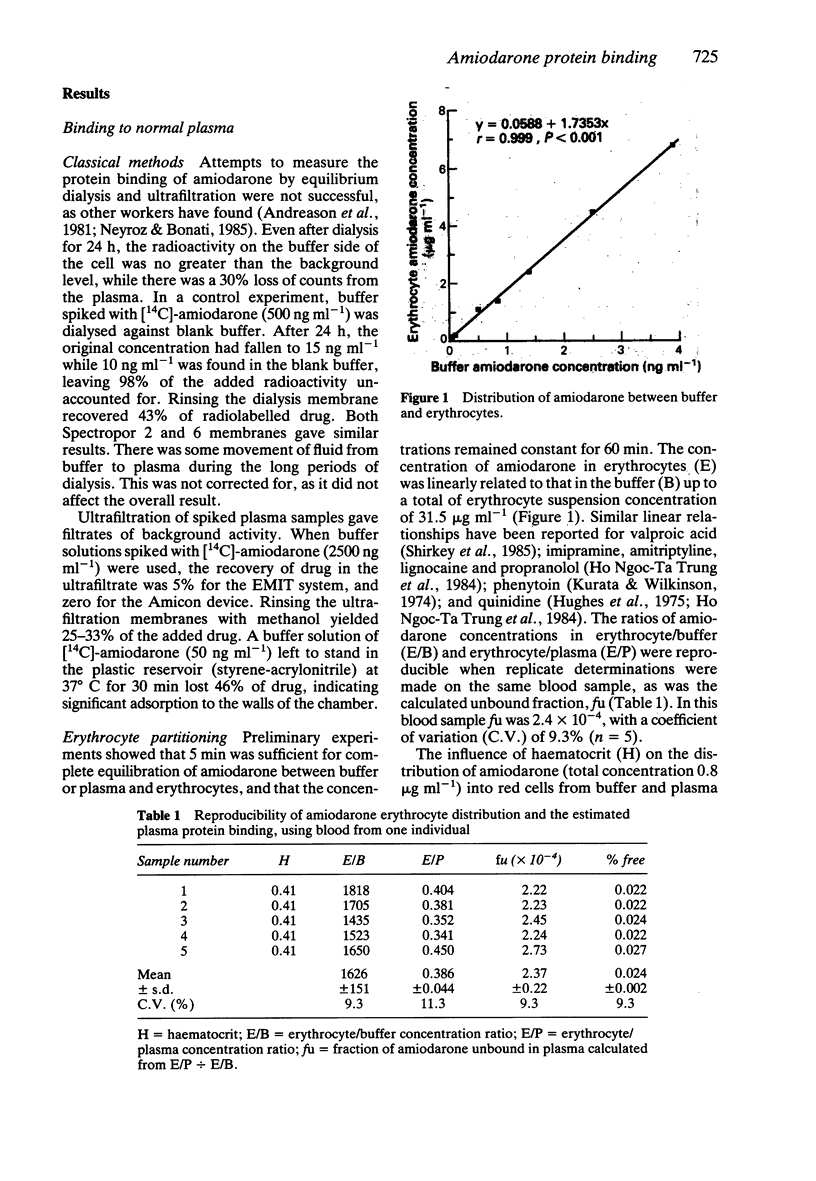
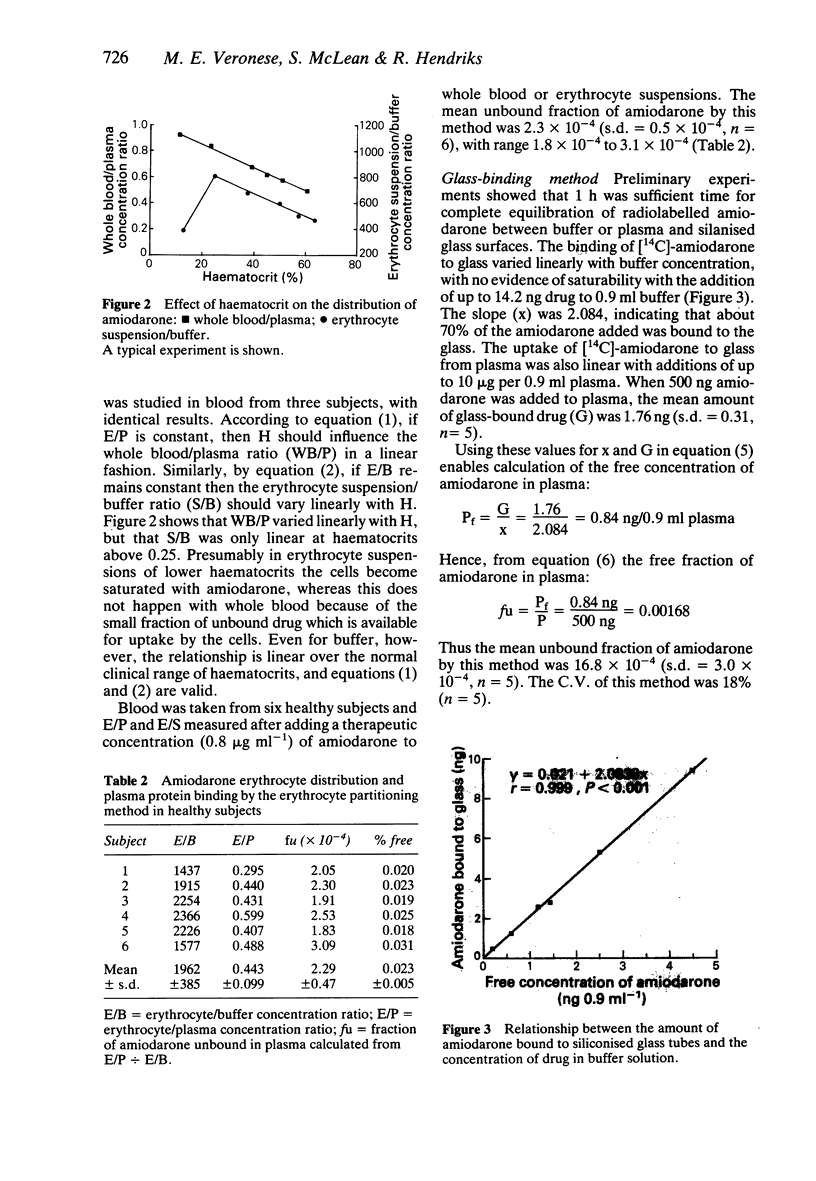
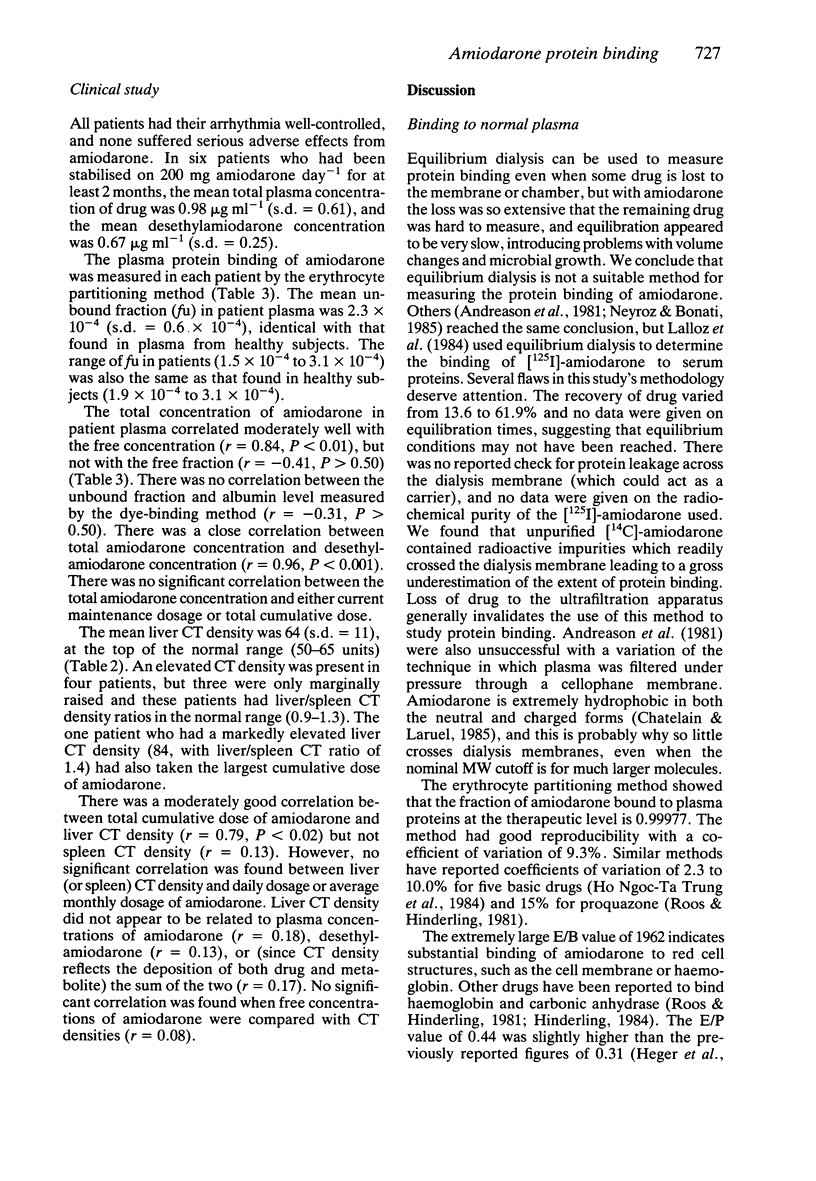
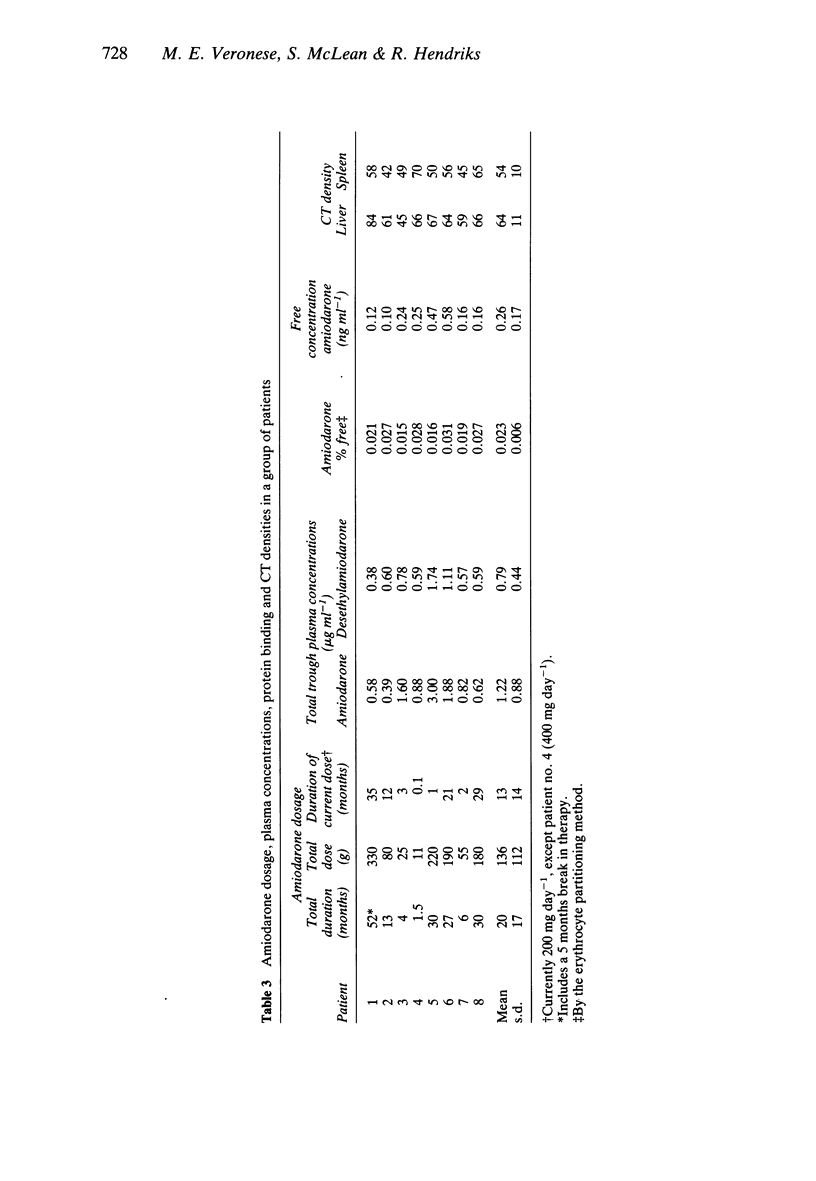
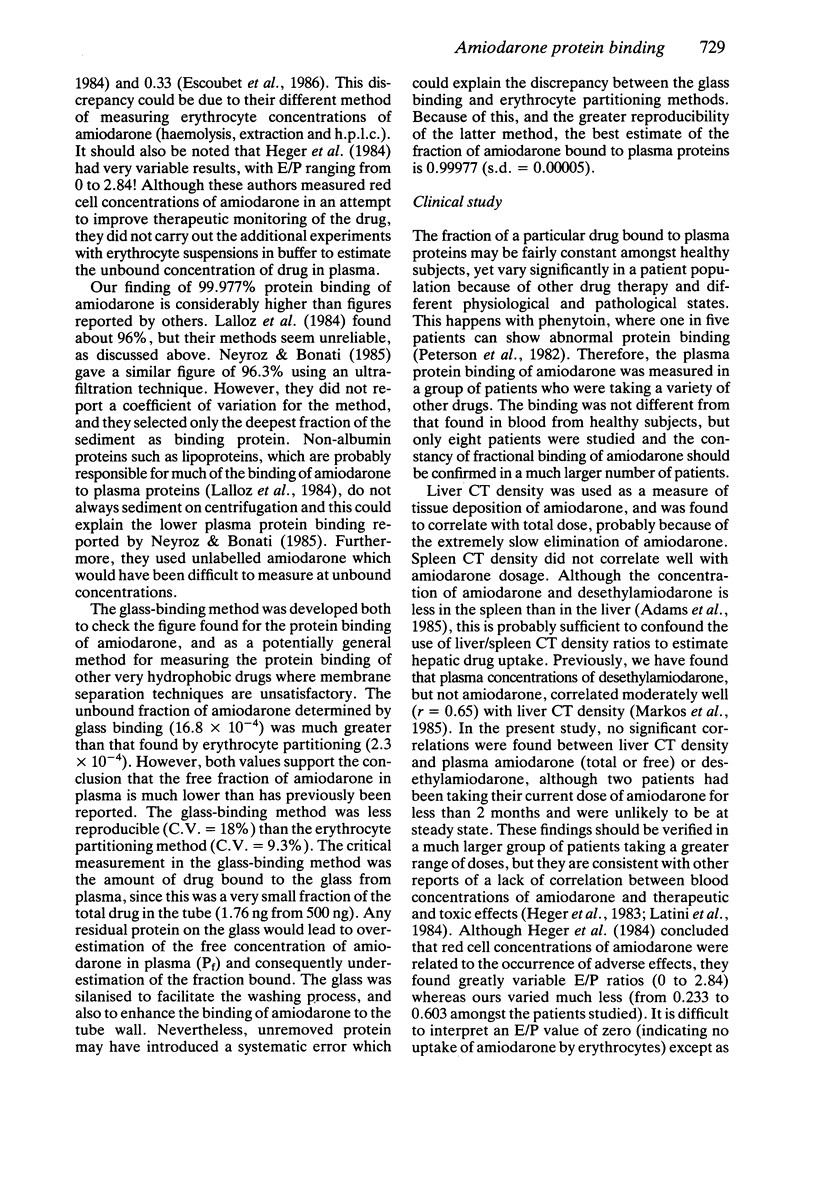
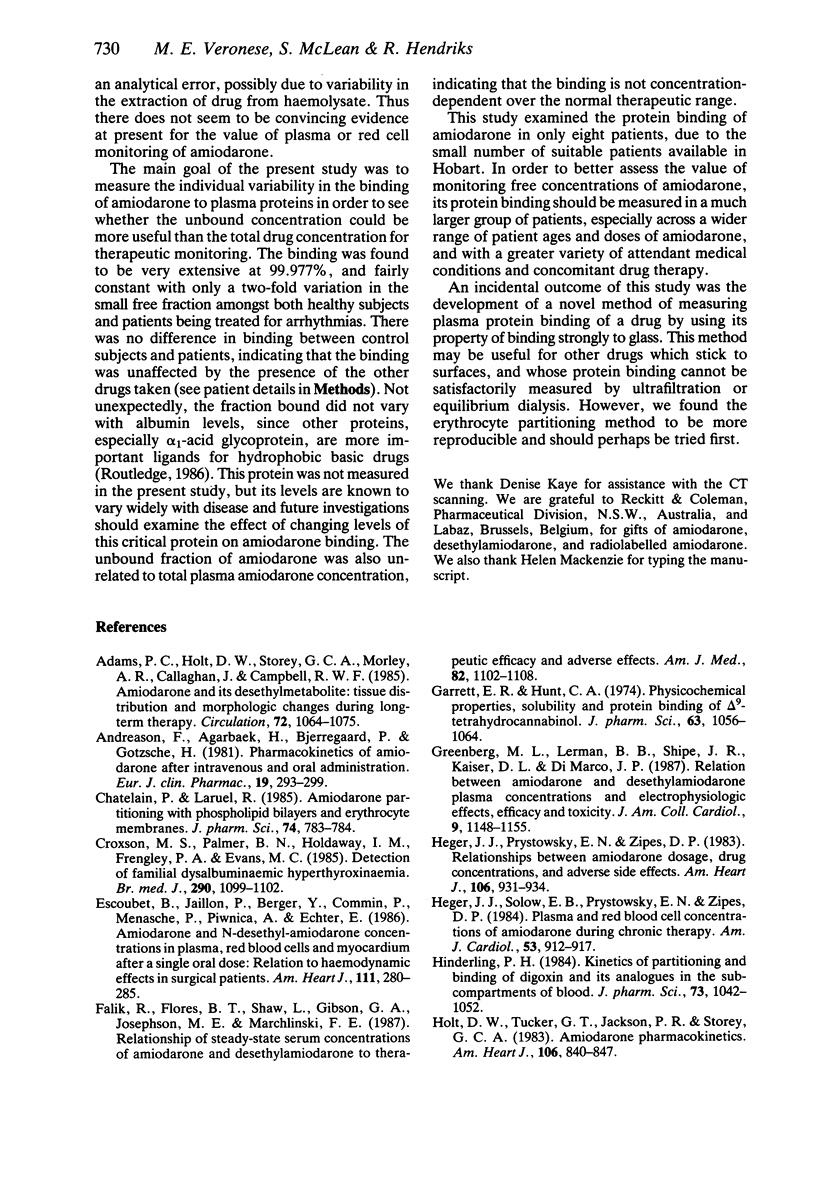
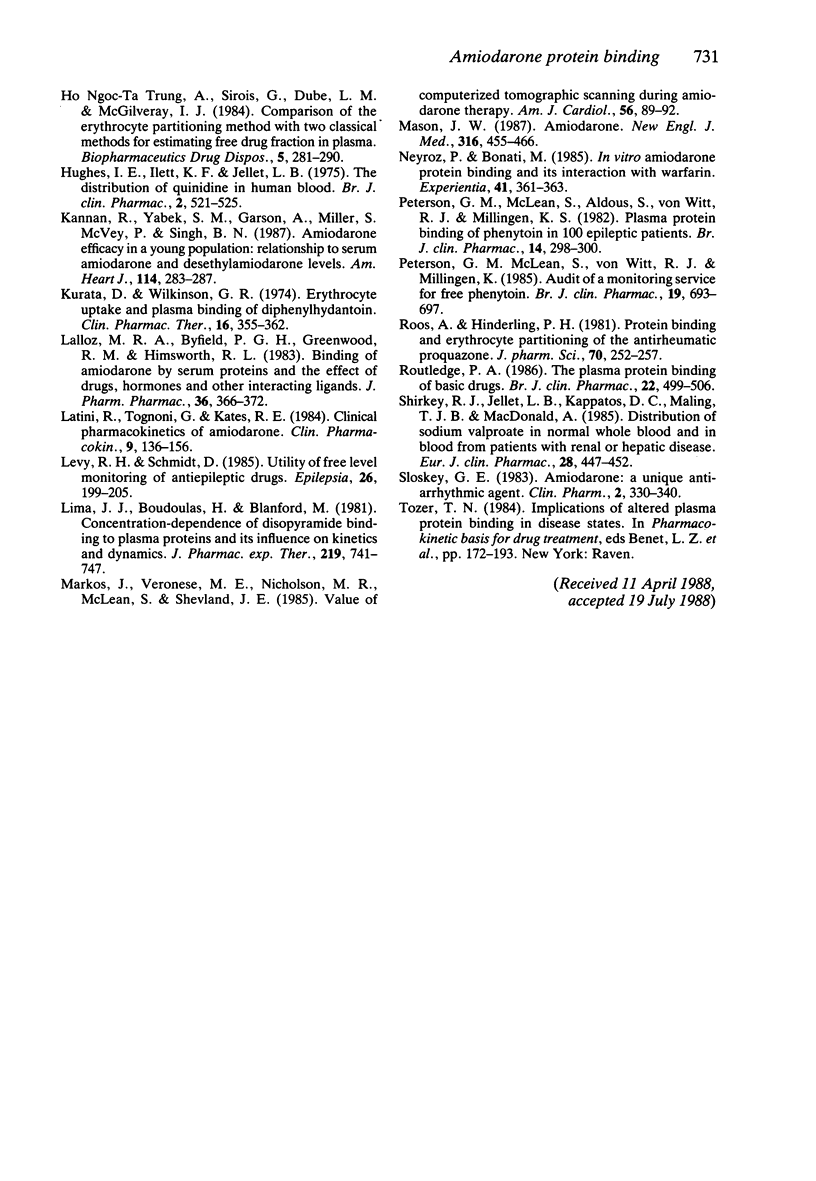
Selected References
These references are in PubMed. This may not be the complete list of references from this article.
- Adams P. C., Holt D. W., Storey G. C., Morley A. R., Callaghan J., Campbell R. W. Amiodarone and its desethyl metabolite: tissue distribution and morphologic changes during long-term therapy. Circulation. 1985 Nov;72(5):1064–1075. doi: 10.1161/01.cir.72.5.1064. [DOI] [PubMed] [Google Scholar]
- Andreasen F., Agerbaek H., Bjerregaard P., Gøtzsche H. Pharmacokinetics of amiodarone after intravenous and oral administration. Eur J Clin Pharmacol. 1981 Mar;19(4):293–299. doi: 10.1007/BF00562807. [DOI] [PubMed] [Google Scholar]
- Chatelain P., Laruel R. Amiodarone partitioning with phospholipid bilayers and erythrocyte membranes. J Pharm Sci. 1985 Jul;74(7):783–784. doi: 10.1002/jps.2600740720. [DOI] [PubMed] [Google Scholar]
- Croxson M. S., Palmer B. N., Holdaway I. M., Frengley P. A., Evans M. C. Detection of familial dysalbuminaemic hyperthyroxinaemia. Br Med J (Clin Res Ed) 1985 Apr 13;290(6475):1099–1102. doi: 10.1136/bmj.290.6475.1099. [DOI] [PMC free article] [PubMed] [Google Scholar]
- Escoubet B., Jaillon P., Berger Y., Commin P., Menasché P., Piwnica A., Echter E. Amiodarone and N-desethylamiodarone concentrations in plasma, red blood cells, and myocardium after a single oral dose: relation to hemodynamic effects in surgical patients. Am Heart J. 1986 Feb;111(2):280–285. doi: 10.1016/0002-8703(86)90140-7. [DOI] [PubMed] [Google Scholar]
- Falik R., Flores B. T., Shaw L., Gibson G. A., Josephson M. E., Marchlinski F. E. Relationship of steady-state serum concentrations of amiodarone and desethylamiodarone to therapeutic efficacy and adverse effects. Am J Med. 1987 Jun;82(6):1102–1108. doi: 10.1016/0002-9343(87)90211-7. [DOI] [PubMed] [Google Scholar]
- Garrett E. R., Hunt C. A. Physiochemical properties, solubility, and protein binding of delta9-tetrahydrocannabinol. J Pharm Sci. 1974 Jul;63(7):1056–1064. doi: 10.1002/jps.2600630705. [DOI] [PubMed] [Google Scholar]
- Greenberg M. L., Lerman B. B., Shipe J. R., Kaiser D. L., DiMarco J. P. Relation between amiodarone and desethylamiodarone plasma concentrations and electrophysiologic effects, efficacy and toxicity. J Am Coll Cardiol. 1987 May;9(5):1148–1155. doi: 10.1016/s0735-1097(87)80320-0. [DOI] [PubMed] [Google Scholar]
- Heger J. J., Prystowsky E. N., Zipes D. P. Relationships between amiodarone dosage, drug concentrations, and adverse side effects. Am Heart J. 1983 Oct;106(4 Pt 2):931–935. doi: 10.1016/0002-8703(83)90018-2. [DOI] [PubMed] [Google Scholar]
- Heger J. J., Solow E. B., Prystowsky E. N., Zipes D. P. Plasma and red blood cell concentrations of amiodarone during chronic therapy. Am J Cardiol. 1984 Mar 15;53(7):912–917. doi: 10.1016/0002-9149(84)90524-1. [DOI] [PubMed] [Google Scholar]
- Hinderling P. H. Kinetics of partitioning and binding of digoxin and its analogues in the subcompartments of blood. J Pharm Sci. 1984 Aug;73(8):1042–1053. doi: 10.1002/jps.2600730807. [DOI] [PubMed] [Google Scholar]
- Holt D. W., Tucker G. T., Jackson P. R., Storey G. C. Amiodarone pharmacokinetics. Am Heart J. 1983 Oct;106(4 Pt 2):840–847. doi: 10.1016/0002-8703(83)90006-6. [DOI] [PubMed] [Google Scholar]
- Hughes I. E., Ilett K. F., Jellett L. B. The distribution of quinidine in human blood. Br J Clin Pharmacol. 1975 Dec;2(6):521–525. doi: 10.1111/j.1365-2125.1975.tb00570.x. [DOI] [PMC free article] [PubMed] [Google Scholar]
- Kannan R., Yabek S. M., Garson A., Jr, Miller S., McVey P., Singh B. N. Amiodarone efficacy in a young population: relationship to serum amiodarone and desethylamiodarone levels. Am Heart J. 1987 Aug;114(2):283–287. doi: 10.1016/0002-8703(87)90492-3. [DOI] [PubMed] [Google Scholar]
- Kurata D., Wilkinson G. R. Erythrocyte uptake and plasma binding of diphenylhydantoin. Clin Pharmacol Ther. 1974 Aug;16(2):355–362. doi: 10.1002/cpt1974162355. [DOI] [PubMed] [Google Scholar]
- Lalloz M. R., Byfield P. G., Greenwood R. M., Himsworth R. L. Binding of amiodarone by serum proteins and the effects of drugs, hormones and other interacting ligands. J Pharm Pharmacol. 1984 Jun;36(6):366–372. doi: 10.1111/j.2042-7158.1984.tb04400.x. [DOI] [PubMed] [Google Scholar]
- Latini R., Tognoni G., Kates R. E. Clinical pharmacokinetics of amiodarone. Clin Pharmacokinet. 1984 Mar-Apr;9(2):136–156. doi: 10.2165/00003088-198409020-00002. [DOI] [PubMed] [Google Scholar]
- Levy R. H., Schmidt D. Utility of free level monitoring of antiepileptic drugs. Epilepsia. 1985 May-Jun;26(3):199–205. doi: 10.1111/j.1528-1157.1985.tb05406.x. [DOI] [PubMed] [Google Scholar]
- Lima J. J., Boudoulas H., Blanford M. Concentration-dependence of disopyramide binding to plasma protein and its influence on kinetics and dynamics. J Pharmacol Exp Ther. 1981 Dec;219(3):741–747. [PubMed] [Google Scholar]
- Markos J., Veronese M. E., Nicholson M. R., McLean S., Shevland J. E. Value of hepatic computerized tomographic scanning during amiodarone therapy. Am J Cardiol. 1985 Jul 1;56(1):89–92. doi: 10.1016/0002-9149(85)90572-7. [DOI] [PubMed] [Google Scholar]
- Mason J. W. Amiodarone. N Engl J Med. 1987 Feb 19;316(8):455–466. doi: 10.1056/NEJM198702193160807. [DOI] [PubMed] [Google Scholar]
- Neyroz P., Bonati M. In vitro amiodarone protein binding and its interaction with warfarin. Experientia. 1985 Mar 15;41(3):361–363. doi: 10.1007/BF02004505. [DOI] [PubMed] [Google Scholar]
- Peterson G. M., McLean S., Aldous S., Von Witt R. J., Millingen K. S. Plasma protein binding of phenytoin in 100 epileptic patients. Br J Clin Pharmacol. 1982 Aug;14(2):298–300. doi: 10.1111/j.1365-2125.1982.tb01981.x. [DOI] [PMC free article] [PubMed] [Google Scholar]
- Peterson G. M., McLean S., von Witt R. J., Millingen K. S. Audit of a monitoring service for free phenytoin. Br J Clin Pharmacol. 1985 May;19(5):693–697. doi: 10.1111/j.1365-2125.1985.tb02697.x. [DOI] [PMC free article] [PubMed] [Google Scholar]
- Roos A., Hinderling P. H. Protein binding and erythrocyte partitioning of the antirheumatic proquazone. J Pharm Sci. 1981 Mar;70(3):252–257. doi: 10.1002/jps.2600700306. [DOI] [PubMed] [Google Scholar]
- Routledge P. A. The plasma protein binding of basic drugs. Br J Clin Pharmacol. 1986 Nov;22(5):499–506. doi: 10.1111/j.1365-2125.1986.tb02927.x. [DOI] [PMC free article] [PubMed] [Google Scholar]
- Shirkey R. J., Jellett L. B., Kappatos D. C., Maling T. J., Macdonald A. Distribution of sodium valproate in normal whole blood and in blood from patients with renal or hepatic disease. Eur J Clin Pharmacol. 1985;28(4):447–452. doi: 10.1007/BF00544365. [DOI] [PubMed] [Google Scholar]
- Sloskey G. E. Amiodarone: a unique antiarrhythmic agent. Clin Pharm. 1983 Jul-Aug;2(4):330–340. [PubMed] [Google Scholar]
- Trung A. H., Sirois G., Dubé L. M., McGilveray I. J. Comparison of the erythrocyte partitioning method with two classical methods for estimating free drug fraction in plasma. Biopharm Drug Dispos. 1984 Jul-Sep;5(3):281–290. doi: 10.1002/bdd.2510050310. [DOI] [PubMed] [Google Scholar]


